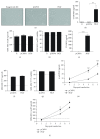Efficient Nonviral Transfection of Human Bone Marrow Mesenchymal Stromal Cells Shown Using Placental Growth Factor Overexpression
- PMID: 30675166
- PMCID: PMC6323439
- DOI: 10.1155/2018/1310904
Efficient Nonviral Transfection of Human Bone Marrow Mesenchymal Stromal Cells Shown Using Placental Growth Factor Overexpression
Abstract
Background: Human mesenchymal stromal/stem cells (hMSCs) hold great therapeutic potential due to their immunomodulatory and tissue regenerative properties. Enhancement of biological features of hMSCs by transfection has become a focus of investigation for cell- and gene-based therapies. However, many of the current transient transfection methods result in either low transfection efficiency or high cytotoxicity.
Methods: In order to find a transfection method that would address the current issues of low transfection efficiency and high cytotoxicity, 6 commercially available cationic lipid and polymer reagents were tested on human bone marrow-derived MSCs (hBM-MSCs) using GFP as a reporter gene. One transfection method using TransIT-2020 was selected and tested with an emphasis on cell quality (viability, identity, and yield), as well as efficacy with a human placental growth factor (PlGF) plasmid.
Results: TransIT-2020 yielded the highest fluorescence signal per cell out of the methods that did not decrease cell recovery. Transfecting GFP to 5 hBM-MSC donors using TransIT-2020 yielded 24-36% GFP-expressing cells with a viability of 85-96%. hBM-MSC identity was unaffected as CD90, CD105, and CD73 markers were retained (>95%+) after transfection. When this method was applied to PlGF expression, there was up to a 220-fold increase in secretion. Both growth and secretion of PlGF in overexpressing hBM-MSC were sustained over 7 days, confirming the sustainability and applicability of the TransIT-2020 transfection system.
Discussion: We report a simple and efficient method for transient transfection that has not been reported for hBM-MSCs, encompassing high levels of plasmid expression without significant changes to fundamental hBM-MSC characteristics.
Figures



Similar articles
-
Electromagnetic fields and nanomagnetic particles increase the osteogenic differentiation of human bone marrow-derived mesenchymal stem cells.Int J Mol Med. 2015 Jan;35(1):153-60. doi: 10.3892/ijmm.2014.1978. Epub 2014 Oct 24. Int J Mol Med. 2015. PMID: 25352086
-
Optimization of high-efficiency transfection of adult human mesenchymal stem cells in vitro.Mol Biotechnol. 2005 May;30(1):9-20. doi: 10.1385/MB:30:1:009. Mol Biotechnol. 2005. PMID: 15805572
-
A comparative study on nonviral genetic modifications in cord blood and bone marrow mesenchymal stem cells.Cytotechnology. 2012 Oct;64(5):523-40. doi: 10.1007/s10616-012-9430-9. Epub 2012 Feb 11. Cytotechnology. 2012. PMID: 22328133 Free PMC article.
-
The immunomodulatory properties of human bone marrow-derived mesenchymal stromal cells are defined according to multiple immunobiological criteria.Inflamm Res. 2016 Jun;65(6):501-10. doi: 10.1007/s00011-016-0933-2. Epub 2016 Mar 8. Inflamm Res. 2016. PMID: 26956767
-
Nucleic acid delivery to mesenchymal stem cells: a review of nonviral methods and applications.J Biol Eng. 2019 Jan 18;13:7. doi: 10.1186/s13036-019-0140-0. eCollection 2019. J Biol Eng. 2019. PMID: 30675180 Free PMC article. Review.
Cited by
-
Amelioration of paraquat-induced pulmonary fibrosis in mice by regulating miR-140-5p expression with the fibrogenic inhibitor Xuebijing.Int J Immunopathol Pharmacol. 2020 Jan-Dec;34:2058738420923911. doi: 10.1177/2058738420923911. Int J Immunopathol Pharmacol. 2020. PMID: 32462952 Free PMC article.
-
Comparison of promoter, DNA vector, and cationic carrier for efficient transfection of hMSCs from multiple donors and tissue sources.Mol Ther Nucleic Acids. 2021 Jul 2;26:81-93. doi: 10.1016/j.omtn.2021.06.018. eCollection 2021 Dec 3. Mol Ther Nucleic Acids. 2021. PMID: 34513295 Free PMC article.
-
Chondrogenic Differentiation of Human Mesenchymal Stem Cells via SOX9 Delivery in Cationic Niosomes.Pharmaceutics. 2022 Oct 28;14(11):2327. doi: 10.3390/pharmaceutics14112327. Pharmaceutics. 2022. PMID: 36365145 Free PMC article.
-
Mesenchymal Stem Cells Engineered by Nonviral Vectors: A Powerful Tool in Cancer Gene Therapy.Pharmaceutics. 2021 Jun 21;13(6):913. doi: 10.3390/pharmaceutics13060913. Pharmaceutics. 2021. PMID: 34205513 Free PMC article. Review.
-
A highly efficient non-viral process for programming mesenchymal stem cells for gene directed enzyme prodrug cancer therapy.Sci Rep. 2020 Aug 31;10(1):14257. doi: 10.1038/s41598-020-71224-2. Sci Rep. 2020. PMID: 32868813 Free PMC article.
References
LinkOut - more resources
Full Text Sources
Research Materials

